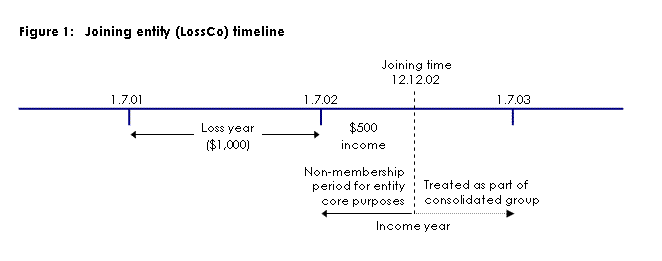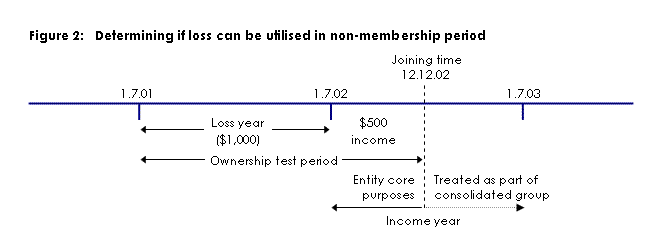Consolidation Reference Manual
You can still refer to the Consolidation reference manual for consolidation information that has not been impacted by changes in the legislation.
C3 Losses
C3-3 Worked example - loss transfer
Establishing the unutilised loss
C3-3-105 Utilising loss in non-membership period - non-membership period is taken to include joining time
Description
This example shows how an entity determines if it can utilise a prior year loss in a non-membership period, where there has been an ownership change at the joining time.
Commentary
Worked exampleAn entity that joins a consolidated group transfers any unutilised losses on hand at the joining time to the head company. However, it must first determine whether any of those losses can be utilised in a non-membership period for which it must work out its core purposes.
Subsection 701-30(3A) states that for the purposes of working out an entity's taxable income (if any) for a non-membership period, the entity needs to determine whether it can use a prior year loss in the period assuming that the time just after the end of the non-membership period were in fact the end of that period. This ensures that any ownership changes that occur at the time it becomes a subsidiary member of a consolidated group are relevant in determining if the entity can utilise the loss in the period.
The rule ensures that the continuity of ownership test (COT) [F1] applies consistently to the joining entity in determining if it can:
- •
- utilise a loss in a non-membership period that ends just before it joins a consolidated group, and
- •
- transfer a loss to the head company of a consolidated group.
Subsection 701-30(3A) also assumes that the business conducted just after the end of the non-membership period (i.e. at the joining time) is the same as the business conducted just before that time. This ensures that for the purposes of applying the same business test (SBT) [F2] as a recoupment test, only the business conducted by the entity as a single entity is considered.
This assumption provides consistency with the application of the SBT as a transfer test under Subdivision 707-A, in that the business conducted by the single entity is not compared with the business conducted by the consolidated group [F3] , despite the fact that the trial year ends just after the joining time [F4] .
Example
Facts
On 12 December 2002, HCo (the head company of a consolidated group) acquires a 70% interest in LossCo, which results in LossCo becoming a wholly-owned subsidiary of HCo.
LossCo has a tax loss on hand from the income year ended 30 June 2002 of $1,000. LossCo's assessable income for the period 1 July 2002 to 11 December 2002 is $500, before any deduction for prior year losses.

Although the income year of LossCo (the joining entity) is from 1 July 2002 to 30 June 2003, its core purposes are calculated in respect of the non-membership period that ended before the joining time, i.e. from 1 July 2002 to 11 December 2002. → Division 701
To establish the amount of loss on hand at the joining time, LossCo needs to bring to account its loss for the 2002 income year in working out its taxable income for the non-membership period 1 July 2002 to 11 December 2002.
Calculation
Subsection 701-30(3A) provides that for the purposes of determining if LossCo is able to utilise the loss in the non-membership period from 1 July 2002 to 11 December 2002, the non-membership period is taken to include the joining time (i.e. the non-membership period is taken to end on 12 December 2002).

As the non-membership period is taken to end at the joining time, the 70% change in LossCo's ownership on 12 December 2002 is relevant in determining if LossCo is able to utilise the 2002 loss in the non-membership period. LossCo has not maintained majority ownership since the start of the loss year (i.e. 1 July 2001), so it has failed to satisfy the conditions in section 165-12 (i.e. it has failed the COT).
Therefore LossCo is only able to utilise the 2002 year loss in the non-membership period if it can satisfy the SBT when comparing:
- •
- the business conducted during the SBT period, which is 1 July 2002 to 12 December 2002 (assuming the business conducted on 12 December 2002 is the same as the business conducted on 11 December 2002), with
- •
- the business conducted at the time just before the COT was failed (the COT was failed on 12 December 2002, when 70% of LossCo's shares were acquired by HCo).
If LossCo is able to satisfy the SBT in respect of these times it can utilise the loss in the non-membership period. This would result in a taxable income of nil for the period (being $500 - $500). The remainder of the loss ($1,000 - $500) incurred in respect of the 2002 income year would then be tested to determine whether it can be transferred to HCo under Subdivision 707-A.
References
Income Tax Assessment Act 1997:
Income Tax Assessment Act 1997 , subsection 701-30(3A) ; as amended by New Business Tax System (Consolidation and Other Measures) Act 2003 (No. 16 of 2003), Schedule 19
Explanatory Memorandum to the New Business Tax System (Consolidation and Other Measures) Bill (No. 2) 2002, Chapter 6
Current at 28 May 2003
Section 165-12
Section 165-13
Subsection 707-120(3) provides that for the purposes of determining if a joining entity conducted the same business throughout the trial year as it carried on at a particular time, it is assumed that the business conducted at and just after the joining time is the same as the business conducted just before the joining time.
Paragraph 707-120(2)(b)
